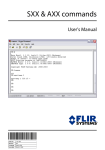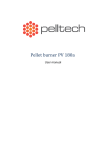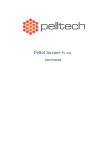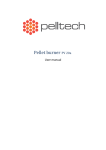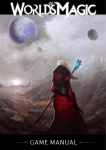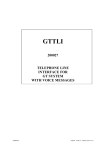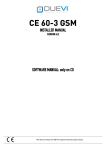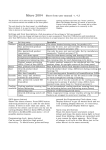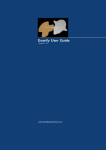Download Information Design Questions
Transcript
Information Architecture Questions The purpose of this document is to help technical communication organizations develop explicit rules and principles related to information architecture, which will serve as a guide to producing high quality technical documentation. This document introduces a number of, (though by no means complete), information architecture questions to help the information architect get started in identifying their own questions. The information designer or architect should preferably answer these questions in the early design stages of a documentation project, or as part of an information analysis. Any technical communicator, or member of a project developing technical documentation, may use this document as a guide. A documentation project including many technical communicators which proceeds to content production without having addressed the following questions, risks running into inefficiencies and quality issues, since each member of the project may answer the questions differently. From the standpoint of SeSAM (Search Situation based Architecture and Methodology), the following questions are answered from the viewpoint of a searching user; prompting technical communicators to predict user questions and design filters with the intention of making answers findable. Contact [email protected] for details on how to design for the searching user. Questions About Information Needs and Target Audience 1. What rules, principles, and methods are you using to identify the type of information end users need? Do you, for example, begin by defining target audiences or user groups? 2. All users that will, at some point, interact with your product should be considered as the population. Imagine putting all these users into one group, meaning a total mix of user types in different life cycle phases etc. What defines whether this total group, (the population), is one target audience, (or user group), or several? 3. If you only have one target audience- how do you identify and define this audience (or population)? a. For example, this could be done by addressing a role in each customer company: “All installators in organization A in country 1, all service engineers in organization B in country 2, all installation and commissioning personnel in organization C in country 3”. 4. If you have several target audiences- how do you define the concept of "target audiences (or user groups)" within the population? Do you cluster: a. …all users with similar background knowledge, (novice, intermediate, experts), as one target audience? b. …all users with similar/same profession/occupation/education/skills, as one target audience? c. …all users who share the same work role (installators, operators, etc.), in a user organization as one target audience? i. What if the work roles are different, (not established as a global “standard”), from one organization to another? Would you then need to decide which organization’s work roles to model the user manual © Excosoft, Issued: 2014-03-24 Page 1 (5) after, or would you create one set of manuals for each organization? ii. What if the technical product is a totally new one, (paradigm shift), on the market, and there are no established work roles? d. ..all users that perform the same tasks, as one target audience? This implies that some tasks must be carried out in a sequence by the same user, and within a specific time frame. You begin by modeling the tasks the user must perform in order to use your product. What you do is group and organize tasks, and then put a target audience label on each task group. Upon what principles do you organize tasks into groups? How many task groups do you come up with? i. A general rule in technical communication is to first identify the user groups, and then proceed to analyze the task they must/can perform. However, if we must first identify the task in order to understand the user groups, then what purpose do the user groups serve? e. …all users who have the required education, skills, and training for a task, within a specific life cycle, as one target audience? This would imply that the tasks are known, and the purpose of categorizing target audiences is to identify their tasks, (which brings us to a "what came first— the chicken or the egg" problem). f. …all users with the same age/gender/nationality, etc. as one target audience? 5. How do you characterize each target audience, like “Installators” or “Operators” or “…”? We could probably identify a lot of key characteristics from a user group labeled “Medical students from Genève University”, for example. Where do you retrieve the data used to characterize a user from? Do you use personas? 6. What type of information, descriptions, and instructions does a target audience need? Why and when? For what purpose (to do what)? a. Are there any other types of information, besides instructions and descriptions, that a target audience needs, (i.e. troubleshooting, etc.)? 7. Does a specific target audience need different types of information depending on the life cycle of the product? a. If so, how do you identify the different phases of a product’s life cycle, (relevant to technical documentation)? b. Examples of life cycle phases: "not purchased", "under installation, deployment or commissioning", "in operation", "out of service". 8. How do you identify what type of information a target audience requires in each phase? 9. How are the instructions that a target audience needs identified? a. By observing users working with the product, and listing all tasks they perform, (or want to perform)? b. By listing all tasks that are possible to perform with the product, (i.e. looking from a product design perspective)? c. By identifying target audiences, and then defining the types of information they need, (i.e. information need matrix)? d. By defining one or several task manuals, and then creating the content hierarchy outline, where each node (title) is an instruction? e. By specifying the life cycle phases for the product, breaking each life cycle down using hierarchical task analysis, (where each task node is a task instruction)? © Excosoft, Issued: 2014-03-24 Page 2 (5) f. By listing the components that constitute the product, and then listing all the tasks that are associated with those components? 10. How is the descriptive content that a target audience needs, (i.e. functional descriptions, etc.), identified? a. By using the task instructions to identify supporting descriptive information needed to perform the task? b. By using the product components as a starting point, and listing different types or aspects of information that describe each of those components? c. By defining one or several descriptive manuals, and then creating the content hierarchy outline where certain nodes represent a type of description? Questions About Task Oriented Information 11. When it comes to achieving a user goal, some tasks must be carried out in a specific sequence, while others may be carried out in any order, (the so called “task plan” in hierarchical task analysis – HTA). How is this assessed, and where in the manual is it stated? a. Some user goals can be achieved in more than one different way, (i.e. variant tasks - you can raise the volume on the TV-set by using the front panel or by using the remote control), where each way has its own set of instructions. How is this assessed, and where in the manual is it stated? 12. There are often mandatory steps or tasks that must be followed in order to get the product into a state where the user’s problem, need, or requirement can be solved. How are these steps assessed, and where in the manual are they stated? 13. Some tasks are mandatory, while others are optional when it comes to making the product do what the user wants. How is this assessed, and where in the manual is it stated? In some cases, before a certain task can be carried out, some other task must be performed first, (the pre-requisite). Prerequisites can take the form of tools, knowledge, instructions, user assistance, etc. How is this assessed, and where in the manual is it stated? 14. Some tasks are related. If you can create something, like a document, you can probably also delete it. How is this relationship assessed and where in the manual is it stated? 15. Some tasks can only be performed once, while others may be carried out an infinite number of times. How is this assessed and where in the manual is it stated? Questions About Descriptive, Conceptual Information 16. The product has one or more purposes, and is used to solve a problem, or meet a need or requirement. How is the purpose assessed, and where in the manual is it stated? 17. A product has a lot of possibilities, and the user can do a lot of things with it, (it brings many benefits). It is advisable to tell the user what he or she can do, and then explain how it is done, (i.e. you can use the product to wash dirty laundry; but how it is done?). How is this assessed, and © Excosoft, Issued: 2014-03-24 Page 3 (5) where in the manual do you offer information about what problems, needs or requirements the product can address? 18. The product imposes requirements on its surrounding context/environment/interface, in order to function properly. How is this assessed, and where in the manual is it stated? 19. The product can most certainly be used in different situations, contexts, and environments. How is this assessed, and where in the manual is it stated? 20. Is an overview or introduction, that provides the big picture, needed? If not, why? If needed, why? 21. The product has an interface from which the user can alter functions, settings, push buttons, icons, menus, and switches. How should these interface components be described? And where in the manual is the corresponding information to be found? 22. A product is often customizable. When a user is customizing, they are planning, calculating, and setting specific values. How do you help the user determine which values to use for a specific customization? 23. When writing, technical communicators must assume a preexisting level of user knowledge. How is this level determined, and should it be explicitly stated in the manual? If not, why? 24. Imagine a product where the user can only perform one task, (i.e. turn the product ON), as the product can do a lot of things automatically and independently without user intervention, (like activating an alarm when a certain threshold has been reached, etc). If this is the case for your product, how do you identify and describe its “automatic functionality”? Questions About How Information is Organized in Manuals 25. Do you organize all information into one manual, or is information distributed across several manuals? What rules define how many manuals need to be created, (for example, one or several for each target audience, etc.)? 26. How do you organize information in a manual, (the static arbitrary hierarchy)? Is it according to a task-oriented or a feature/functional/product component-oriented principle? 27. What rules define how the different task instructions are organized in manuals? Are instructions organized according to lifecycle phases, (derived from a hierarchical task analysis), or according to target groups, or related product structure components? Or do you list all tasks in alphabetical order? 28. Are instructions organized in a hierarchy? If so, why and according to what principle? 29. How is descriptive content organized in a manual? According to target groups, product components they describe, or according to the task it relates to? 30. Are descriptions organized in a hierarchy? what principle? © Excosoft, Issued: 2014-03-24 If so, why, and according to Page 4 (5) 31. Is descriptive- and task-oriented information mixed (mixed content) in the same manual/chapter/section? If so, is the overall content hierarchy in the manual task oriented or feature/functional/product/component- oriented? Or is the task-oriented information organized in one part of the manual, and descriptive in another? 32. Can the same information be repeated in several different manuals, (then placed into one manual where it can be referenced from other manuals as needed)? If not, why? 33. What if the same descriptive supporting information is needed from many different task nodes, target groups, or product components? Can a description be repeated in the same manual, or is information organized in a separate manual, or placed in a generic location and then referenced as needed? 34. What defines how many chapters a manual should include? What rules define how the chapters are organized? 35. What rules define what information is presented in the first chapter? 36. Can the chapters be organized in any order in a given manual? 37. Can you switch two defined chapters in a manual, or is the order fixed? If not, why? 38. How many subsections do you allow, and how extensive do you recommend the hierarchy in each chapter to be, and why? 39. How many sibling children shall a node in a manual maximum have? 40. Some tasks are probably carried out more frequently than others. How is this analyzed, and how is the content hierarchy of a manual built to take this into account? 41. Information for certain tasks must be made quick and easy to find, (i.e. an alarm or error that needs immediate attention). How is this assessed, and how is the content hierarchy in a manual built to take this into account? Questions for Topic-based Environments (DITA, IMAP, etc.) 42. What rules define the size of a DITA topic/information module/fragment etc., (the topic granularity)? 43. A topic, (i.e. a DITA topic), describes a subject, an entity, or an idea. But what is the definition of a subject, an entity, or an idea? 44. Can several topics of the same information type, (either a DITA task, concept, or reference), relate to or describe the same subject? If so, why? Why several topics as opposed to only one? 45. Can topics of different information types describe the same subject? If so, how is that determined? 46. Can one task topic contain sub tasks that address several goals? If so, why? What determines whether a user task becomes several task topics, or becomes one single task topic with a procedure step list included? © Excosoft, Issued: 2014-03-24 Page 5 (5)





